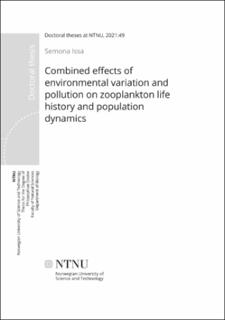| dc.contributor.advisor | Einum, Sigurd | |
| dc.contributor.advisor | Jaspers, Veerle | |
| dc.contributor.author | Issa, Semona | |
| dc.date.accessioned | 2021-02-24T07:34:48Z | |
| dc.date.available | 2021-02-24T07:34:48Z | |
| dc.date.issued | 2021 | |
| dc.identifier.isbn | 978-82-326-5548-9 | |
| dc.identifier.issn | 2703-8084 | |
| dc.identifier.uri | https://hdl.handle.net/11250/2729953 | |
| dc.description.abstract | Toxicity studies on aquatic organisms are commonly conducted under highly standardized conditions that exclude interactions with environmental factors. However, aquatic organisms such as Daphnia regularly experience environmental variation, which may interact with pollutants to influence important characteristics of their populations. Moreover, plastic responses to environmental variation are underlined by neural mechanisms. Hence, exposure to antidepressants can alter these responses with potential effects to individual fitness and population viability. With focus on metal and pharmaceutical pollution, this thesis investigates individual and population-level effects of metals and antidepressants under different environmental scenarios in aquatic ecosystems, using laboratory experiments involving Daphnia magna as a focal species.
Using standardized laboratory tests that prevent biofilm growth may result in inaccurate estimates of mercury (Hg) toxicity to zooplankton. We found that biofilm presence decreased the accumulation of Hg, while increasing the tissue Se content in Daphnia. By serving as a dietary source of selenium to Daphnia, biofilm potentially alleviated the toxic effects of Hg. Excluding interactions with temperature and population density may also lead to inaccurate estimates of Hg toxicity. Indeed, the effect of Hg on biomass growth rate became unimportant when effects of temperature and population density were included. As for resting egg production, a crucial long-term fitness component of Daphnia, a significant effect of Hg was observed at low temperature only. Hence, when temperature and population density effects were included, sexual reproduction responded to environmentally relevant concentrations of Hg, whereas population growth did not.
In the case of antidepressants, exposure to aqueous dopamine and bupropion, a dopamine reuptake inhibitor, changed the slopes of life-history reaction norms in response to food abundance. This finding supported an important role of dopamine as regulator of life-history responses to food abundance in Daphnia. The observed changes translated into an advanced timing of reproduction at the expense of adult size and offspring size when food was limited. Accelerated life cycles in turn resulted in higher population growth rates, without any costs to longevity. This apparent boost in fitness raised the question of why Daphnia do not evolve towards higher endogenous dopamine levels. The observed smaller offspring size from maternal exposure to dopamine was thereafter investigated for potential negative effects on offspring survival under starvation. Indeed, body size in Daphnia is positively correlated with filtering rates, hence feeding rates. However, despite their smaller size, offspring from dopamine-exposed mothers overall survived better under starvation than controls. Hence, no costs to offspring survival and fitness from enhanced maternal dopamine levels were detected. Further research on the ultimate and proximate costs of higher dopamine production is needed to better understand the evolution of the dopamine system.
With focus on metal and pharmaceutical pollution, this thesis demonstrates that effects of chemicals on individuals and populations vary with environmental conditions. By measuring effects of chemicals at environmentally relevant concentrations and under more natural conditions, more realistic estimates of toxicity can be obtained. Furthermore, this thesis supports a role for dopamine as regulator of life-history responses to food abundance in species, as previous studies focused mainly on morphological and behavioral responses. Finally, the work in this thesis demonstrates the potential for using chemical exposures in evolutionary research. | en_US |
| dc.language.iso | eng | en_US |
| dc.publisher | NTNU | en_US |
| dc.relation.ispartofseries | Doctoral theses at NTNU;2021:49 | |
| dc.relation.haspart | Paper 1: Issa, Semona; Ciesielski, Tomasz Maciej; Mikkelsen, Øyvind; Einum, Sigurd; Jaspers, Veerle. Biofilms grown in aquatic microcosms affect mercury and selenium accumulation in Daphnia. Ecotoxicology 2020 ;Volum 29.(4) s. 485-492
https://doi.org/10.1007/s10646-020-02194-4
This article is licensed under a Creative Commons
Attribution 4.0 (CC BY 4.0) | en_US |
| dc.relation.haspart | Paper 2: Issa, Semona; Gamelon, Marlène; Ciesielski, Tomasz Maciej; Vike-Jonas, Kristine; Asimakopoulos, Alexandros; Jaspers, Veerle; Einum, Sigurd. Dopamine mediates life history responses to food abundance in Daphnia. Proceedings of the Royal Society of London. Biological Sciences 2020 ;Volum 287. Suppl. 20201069
http://dx.doi.org/10.1098/rspb.2020.1069
This article is licensed under a Creative Commons
Attribution 4.0 (CC BY 4.0) | en_US |
| dc.relation.haspart | Paper 3: Issa, Semona; Simonsen, Ane; Jaspers, Veerle; Einum, Sigurd. Population dynamics and resting egg production in Daphnia: Interactive effects of mercury, population density and temperature. Science of the Total Environment 2021
https://doi.org/10.1016/j.scitotenv.2020.143625
This article is licensed under a Creative Commons
Attribution 4.0 (CC BY 4.0) | en_US |
| dc.relation.haspart | Paper 4:
Issa, Semona; Chaabani,Safa; Asimakopoulos, Alexandros G.; Jaspers, Veerle L.B; Einum, Sigurd.
Maternal dopamine 1 exposure in Daphnia boosts the survival of starved offspring. | en_US |
| dc.title | Combined effects of environmental variation and pollution on zooplankton life history and population dynamics | en_US |
| dc.type | Doctoral thesis | en_US |
| dc.subject.nsi | VDP::Mathematics and natural science: 400::Basic biosciences: 470 | en_US |

